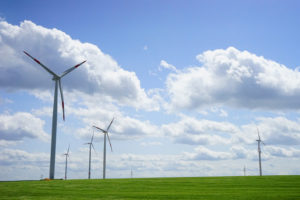
It’s endlessly surprising what you’ll discover if you look up…
What does a ‘wind turbine’ look like? Unsurprisingly, you likely imagine something like this:

Which is good, because that is what a wind turbine looks like. It’s effectively the exact same principle that’s been exploited ever since these guys first started popping up:

But since long before both of these, we’ve been harnessing the wind to propel us forward through other methods. Both literally via the sails of a ship, and metaphorically through an even earlier milling technology…
Because when we look up at the second floors, the roofs, and beyond, places in which we’ve spent our whole lives can reveal a whole other world. After all, when you’re walking down the highstreet, knowing what shops are around you is a higher priority than how many of those buildings still have superfluous chimneys (although that’s an exercise I fully encourage). Sometimes, it takes a special something to draw the eye away.
That was the case a few years ago, on my way to the train station. A flashing at first, and then a spinning: something white atop the station multi-storey car park. It was a turbine, certainly, but not one reminiscent of grain-grinding – more so one of immediate blending. Possibly even weather-recording instrumentation? But no, there’s three of them. And they’re big, too; if these were made for making measurements only, some engineers clearly got a bit carried away on their prototype designs (although that’s another exercise I tend to endorse).
These things must be generating power, because if they’re not – they should be.
I tried to shrug it off, that answer was surely the end. But it stuck to me. Why are they such a drastically different design? Why are they installed there in particular? How many of those chimneys are still functional? No, that one can wait until later.
I had witnessed a flock of these things:

They’re vertical axis wind turbines (VAWTs), and they’re fantastic. Specifically, these are known as helical ‘Darrieus’ turbines.
First, the similarities. Both turbine types rely on the same underlying physical principles as sails and wings: the kinetic energy of the wind itself, and the pressure differentials that come as a result of it. Wind turbine blades are all but in name ‘wings’ – they’re simply balanced against one another so that instead of taking off, all of that energy is applied as torque. They are birds that never leave the ground: lacking in the flavour of chicken, but much more energetic.
Now, the differences: horizontal (ie ‘traditional’) wind turbines are far more efficient at scale, generating energy and voltage of a kind more ideal for supplying the grid. This comes at the cost of much stricter directional requirements: they have to turn to face the wind. You could say that vertical axis turbines, however, always face the wind. Or, conceptually, they face outwards on all sides simultaneously. They work with any wind direction, at the expense of lower efficiency.
Vertical turbines are smaller and generally ‘safer’, too. Safer in the sense that huge horizontal turbines still need to be built away from residential areas for ‘just in case’ reasons. And smaller in the sense that they’re not larger (and can thus be built closer together before interfering with each other via their relatively short and choppy wake turbulence). So you simply won’t find large horizontal turbines on rooftops, at least no where near as frequently. And you won’t find vertical turbines in large open fields, at least not with current technology.
So there’s one answer: this car park has VAWTs because it can’t have HAWTs.
We could stop there, but that’s not quite enough for me. Okay, but why have them at all then? If HAWTs are more efficient, why not just build them elsewhere?
The answer is simple, we just have to challenge a single assumption: what are these things plugged into?
If we answer with anything but ‘the grid’, then their purpose becomes apparent: local supply. For instance: carpark lighting. VAWTs make for ideal local energy generation day and night, with little maintenance, relatively low initial investment cost (compared to the kind of building we’re talking about here), and hey, they’re pretty pretty too.
And you know what? Vertical axis wind mills came first.

 (4 votes, average: 4.00 out of 5)
(4 votes, average: 4.00 out of 5)